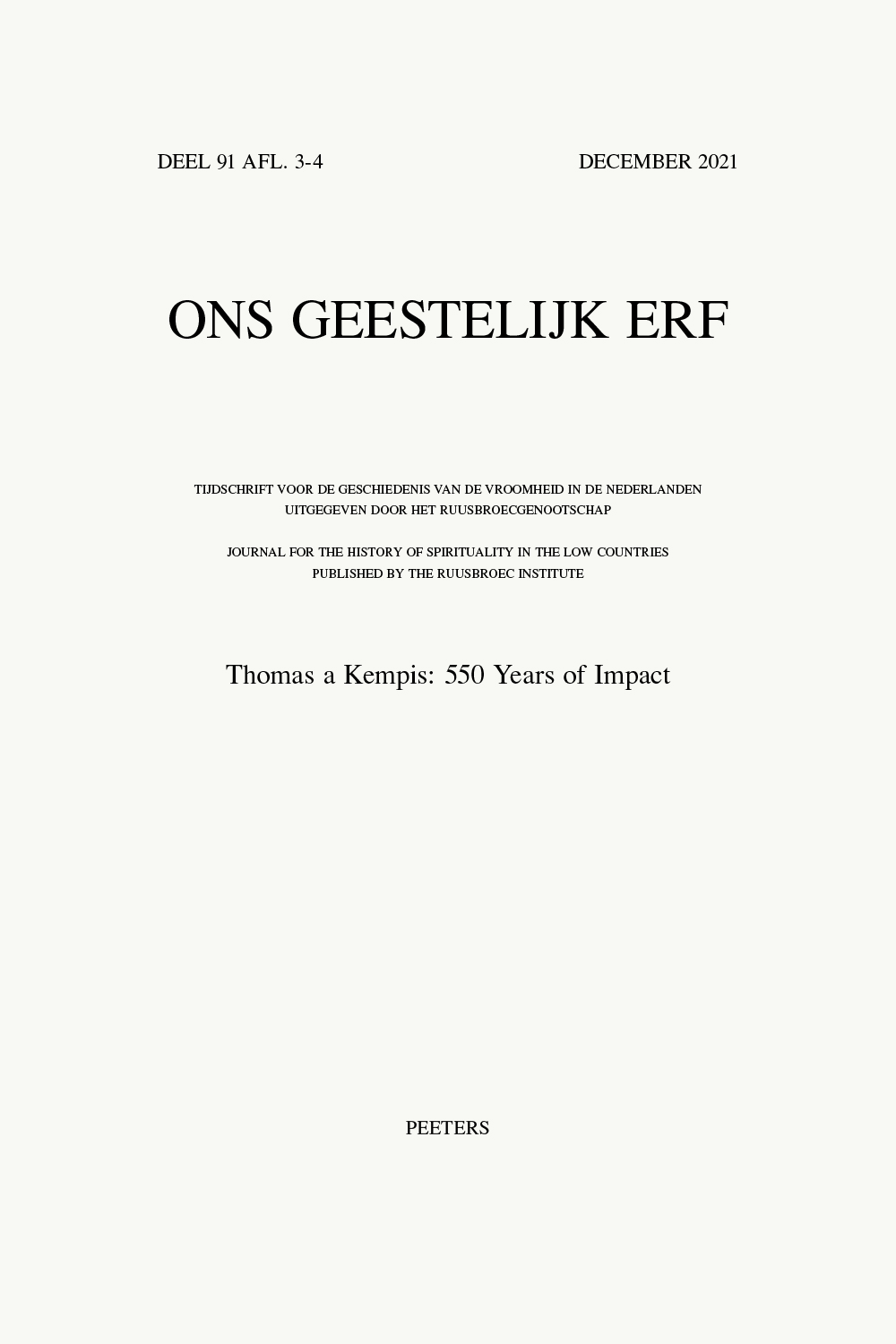 previous article in this issue previous article in this issue | next article in this issue  |

Preview first page |
Document Details : Title: Metaphors of Transcendence and Transformation in the Arnhem Mystical Sermons (Royal Library, The Hague, ms. 133 H 13) Subtitle: Moses' Ascent of Mount Sinai as an Allegory for Mystical Experience Author(s): CORNET, Ineke Journal: Ons Geestelijk Erf Volume: 79 Issue: 4 Date: December 2008 Pages: 369-396 DOI: 10.2143/OGE.79.4.2033314 Abstract : The St. Agnes monastery played an important role in both the production of mystical literature, as well as the publication flow of the Carthusian Charterhouse in Cologne that was used to defend and strengthen the Catholic Church in the context of the sixteenth century rise of Protestantism. One of the most important Middle Dutch mystical sermon collections, the Arnhem Mystical Sermons (Royal Library the Hague, ms. 133 H 13), has been proven to originate from this St. Agnes monastery. This article contains a case-study on metaphors in the mystical exegesis of the narrative of Moses’ ascension of Mount Sinai, to shed more light on mystical theological concepts in the Arnhem Mystical Sermons. These metaphors are especially compared with fourteenth century vernacular mysticism of Rhineland and Brabant, when the vernacular mysticism in these regions reached its summit. The Arnhem Mystical Sermons witness to a revival of especially fourteenth century mystics in a specific synthesis of both Brabant and Rhineland mysticism. The first metaphor, ground, is a key concept in mystical anthropology. The transcendent nature of God can only be experienced by the person’s innermost being. The preparatory stage for the mystical experience is self-release in order to turn inwards. In accordance with many other Middle Dutch and Middle German mystics the sermons depict the human innermost core mostly with the metaphors of ground and abyss. The ground of the human being is bottomless, because the infinite God dwells within him or her. Therefore, one’s ground is ultimately hidden for oneself. A radical apophatic anthropology is combined with a radical apophatic portrayal of the divinity. Darkness and nothingness are powerful metaphors of negative theology, emphasising God’s transcendence. Darkness indicates the self-release necessary for experiencing God without intermediaries, as well as the overbrightness of God’s light. The mystic experiences that God’s light is unbearable for humanly, limited perception. The metaphor of darkness is especially employed to portray God’s Being that is Oneness. Nevertheless, this incomprehensibility of God does not exclude a positive evaluation of the Ruusbroecian understanding of the Trinity: God’s incomprehensible Oneness is the loving unity of the three distinct persons of Father, Son and Holy Spirit. The metaphor of nothingness portrays the transcendence of God in a radical way. Nothingness articulates that God’s being transcends the human way of being. Parallel to the depiction of the Divinity, the metaphor also illustrates that the innermost part of the human being is nothingness, because God’s nothingness lives in the soul. The Arnhem Mystical Sermons adhere to the Pseudo-Dionysian and Eckhartian radical negative theology and anthropology, and employ the controversial terminology despite the condemnation in the papal bull In Agro Dominico. The Arnhem Mystical Sermons portray God’s nature as love. Mystical experience is therefore an experience of love. This is described as the “unity without distinction” on the experiential level, again an expression in the works of Ruusbroec and Eckhart that was perceived as controversial. The intensity of God’s love is the basis for the transformative effect upon the human being. Both the metaphors of light expelling darkness and all-consuming fire express this transformative power of the mystical unity: the human being is made divine. This divinisation means that God lives in the human being and fills the whole humanity with divine love. This transformation through the loving presence of God in those who are self-released is what ultimately matters, whether or not it is accompanied by short mystical experiences of God. The spirituality of St. Agnes is distinguished by a desire for intensity in mystical experience, and at the same time a desire to remain down-to earth and to emphasise the necessity of deepening the practical, virtuous life. The Arnhem Mystical Sermons are characterised by a combination of more intellectual, speculative mysticism in the line of Pseudo-Dionysius’ and Eckhart’s negative theology, the trinitarian mysticism of Ruusbroec, and the more affective spirituality, in which the encounter with and the transformation through God’s love is emphasised. The Arnhem Mystical Sermons testify to a mysticism that is deeply rooted in the multifarious nature of the Christian mystical tradition. |
|


